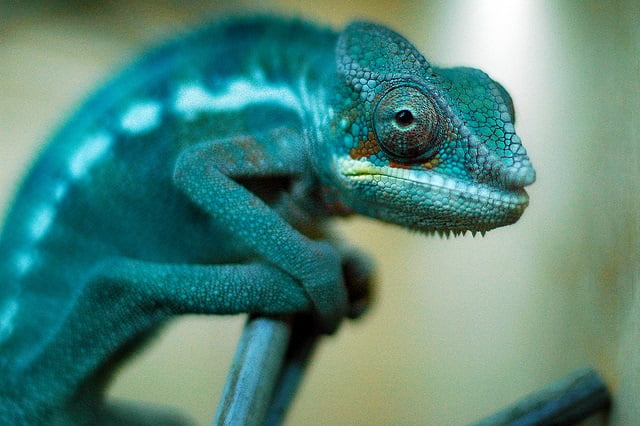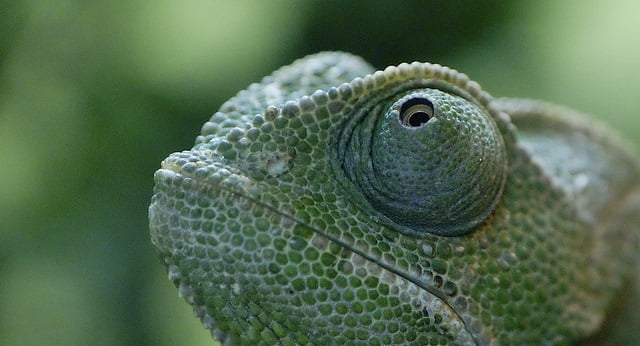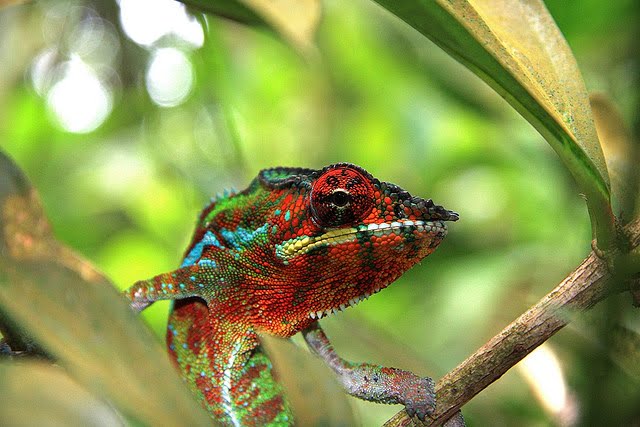Well known among nature’s best tricksters for their ability to change color to fit their background, chameleons have yet another talent up their lizardly sleeves – eyes that swivel around and appear to be looking in two directions at once.
In contrast to humans, who have to turn their heads to have a wider but still relatively narrow field of vision, chameleons enjoy a wider field of vision with the ability to swivel each of their eyes in a different direction. Called ‘voluntary strabismus,” this ability enables the chameleon to minimize its body movements to reduce the likelihood of revealing its presence to those it hunts as well as to those that might hunt them.
SEE ALSO: No Bat About It: Bats Eavesdrop To Help Friends Find Food
Is this crazy adaptation really an example of this reptile’s eyes each being independent of the other, thus enabling them to simultaneously see two different views of their world?
Chameleon computer games
To Professors Ehud Rivlin of the Technion-Israel Institute of Technology, and Prof. Gadi Katzir of the University of Haifa, this seemed like an intriguing research question. They went about answering that question by getting chameleons to play a computer game especially designed to potentially frustrate the creatures, yet possibly solve the riddle of whether chameleons really enjoy ‘eye independence.’
When the researchers showed chameleons a double image of a tiny insect moving opposite directions across a computer screen, the reptiles focused first on one image with one eye while the other eye “wandered.” Suddenly, both eyes locked on one image a nanosecond before the reptile cocked its dart-like, sticky tongue and fired at-will.
“There were a few seconds of indecision when the chameleons were deciding which target to shoot at,” said Prof. Rivlin. “If the eyes were truly independent, one would not expect one eye to stay put and then have the other eye converge. But we found that once the chameleon made its decision about which target to fire on, it swiveled the second eye around to focus on the same simulated fly the first eye was locked on.”
This behavior pattern, said the researchers, suggests that the second eye has knowledge of where the first eye is directed. That the chameleons are able to track objects moving in opposite directions before deciding which one to target suggests that their eyes are not really independent, as many have believed.
Sign up for our free weekly newsletter
SubscribeSEE ALSO: Knot So Fast: Israeli Researchers Discover Incredible Self-Defense Mechanism
“Their eyes possibly engage in some kind of ‘cross talk,’” suggested Prof. Rivlin.
When chameleon eye cross talk occurs and the second eye locks onto the same target as the first, the expert predator of tiny insects gets the necessary stereoscopic depth perception at just the right moment for accurate striking.
What we share with chameleons
Chameleons, of which there are over 200 species, are denizens of tropical climates and deserts, but widely kept as pets the world over. They have intrigued scientists and non-scientists alike with their ability to change color and skin textures and their seemingly roaming, independent-looking eyes.
According to the researchers, many animals – especially fish and birds, but not mammals – have wandering, independent eyes, with each eye connected to the opposite side of the brain so that the left part of the brain knows what the right eye is doing, and vice-versa. That’s more common than we realize, they said.
But, no surprise, chameleons are different.
“We demonstrated that when chameleons are presented with two small targets moving in opposite directions, they can perform simultaneous, smooth, monocular visual tracking,” said Prof. Rivlin. “To our knowledge, this is the first demonstration of this capacity. We suggest that in chameleons, eye movements are not simply ‘independent,’ but are disconjugate (not paired in acting) during scanning, conjugate (paired in action) during binocular (two-eye) tracking, and disconjuate but coordinated during monocular (one-eyed) tracking. Each eye is aware of its own location and the orientation of the other eye. It is just a different kind of cooperation that takes place in human binocular vision.”
Related posts

Resilient And Nutritious New Plant-Based Milk Aims To Make A Splash

Chocolate From Cultivated Cocoa Comes Without Environmental Toll

Plastic Fantastic: Startup Takes PVC Back To Its Crude Oil Roots







Facebook comments